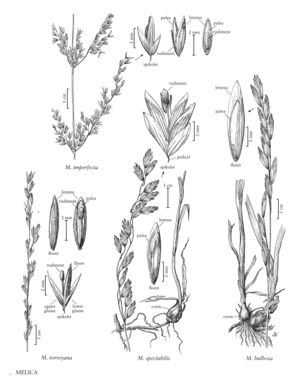Difference between revisions of "Melica imperfecta"
FNA>Volume Importer |
FNA>Volume Importer |
||
| Line 8: | Line 8: | ||
|name=Melica imperfecta var. refracta | |name=Melica imperfecta var. refracta | ||
|authority=unknown | |authority=unknown | ||
| − | }}{{Treatment/ID/Synonym | + | }} {{Treatment/ID/Synonym |
|name=Melica imperfecta var. minor | |name=Melica imperfecta var. minor | ||
|authority=unknown | |authority=unknown | ||
| − | }}{{Treatment/ID/Synonym | + | }} {{Treatment/ID/Synonym |
|name=Melica imperfecta var. flexuosa | |name=Melica imperfecta var. flexuosa | ||
|authority=unknown | |authority=unknown | ||
| Line 26: | Line 26: | ||
-->{{Treatment/Body | -->{{Treatment/Body | ||
|distribution=Calif.;Ariz.;Nev. | |distribution=Calif.;Ariz.;Nev. | ||
| − | |discussion=<p>Melica imperfecta grows from sea level to 1500 m, on stable coastal dunes, dry, rocky slopes, and in open woods, from California and southern Nevada south to Baja California, Mexico. Plants vary with respect to size, panicle shape, and pubescence, but no infraspecific taxa merit recognition. Boyle (1945) obtained vigorous, almost completely sterile hybrids between M. imperfecta and both M. torreyana and M. californica, but found no examples of natural hybrids.</p> | + | |discussion=<p><i>Melica imperfecta</i> grows from sea level to 1500 m, on stable coastal dunes, dry, rocky slopes, and in open woods, from California and southern <i>Nevada</i> south to Baja California, Mexico. Plants vary with respect to size, panicle shape, and pubescence, but no infraspecific taxa merit recognition. Boyle (1945) obtained vigorous, almost completely sterile hybrids between <i>M. imperfecta</i> and both <i>M. torreyana</i> and <i>M. californica</i>, but found no examples of natural hybrids.</p> |
|tables= | |tables= | ||
|references= | |references= | ||
| Line 47: | Line 47: | ||
|publication year= | |publication year= | ||
|special status= | |special status= | ||
| − | |source xml=https://jpend@bitbucket.org/aafc-mbb/fna-data-curation.git/src/ | + | |source xml=https://jpend@bitbucket.org/aafc-mbb/fna-data-curation.git/src/8f726806613d60c220dc4493de13607dd3150896/coarse_grained_fna_xml/V24/V24_107.xml |
|subfamily=Poaceae subfam. Pooideae | |subfamily=Poaceae subfam. Pooideae | ||
|tribe=Poaceae tribe Meliceae | |tribe=Poaceae tribe Meliceae | ||
Revision as of 16:17, 18 September 2019
Plants densely cespitose, not rhizomatous. Culms 35-120 cm, not forming corms; internodes scabridulous immediately above the nodes. Sheaths glabrous or pilose; ligules 0.8-6.5 mm; blades 1-6 mm wide, abaxial surfaces glabrous or puberulent, adaxial surfaces with hairs. Panicles 5-36 cm; branches 2.5-9 cm, appressed to reflexed, straight or flexuous, with 5-30 spikelets; pedicels not sharply bent; disarticulation above the glumes. Spikelets 3-7 mm, with 1(2) bisexual florets; rachilla internodes 0.3-0.6 mm. Lower glumes 2-5 mm long, 1-2 mm wide, 1-veined; upper glumes 2.5-6 mm long, 1.5-2.5 mm wide, 1-veined; lemmas 3-7 mm, glabrous, sometimes scabrous, with 7+ veins, veins prominent, apices rounded to acute, unawned; paleas almost as long as the lemmas; anthers 1.5-2.5 mm; rudiments 1-4 mm, not resembling the lower florets, longer and thicker than the terminal rachilla internode, truncate to obtuse. 2n = 18.
Distribution
Calif., Ariz., Nev.
Discussion
Melica imperfecta grows from sea level to 1500 m, on stable coastal dunes, dry, rocky slopes, and in open woods, from California and southern Nevada south to Baja California, Mexico. Plants vary with respect to size, panicle shape, and pubescence, but no infraspecific taxa merit recognition. Boyle (1945) obtained vigorous, almost completely sterile hybrids between M. imperfecta and both M. torreyana and M. californica, but found no examples of natural hybrids.
Selected References
None.
